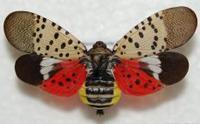Help stop spotted lanternfly

With the news that the spotted lanternfly has been found in Iowa, the Colorado Department of Agriculture launched a new informational website in early August to help teach Coloradans and visitors about how to identify and eradicate the invasive spotted lanternfly. The website can be accessed at ag.colorado.gov/slf.
“The spotted lanternfly is an invasive pest that could decimate Colorado’s signature crops like peaches, grapes, hops and more than 70 other species of plants,” said Rich Guggenheim, plant health certification program manager. “The spotted lanternfly is a notorious hitchhiker, and Coloradans as well as travelers visiting our state should know what to look for to stop this invasive and destructive pest before it enters our state.”
The spotted lanternfly, Lycorma delicatula, is native to Asia and was first discovered in the United States in Pennsylvania in 2014. As of early August, SLF has been found in 12 states: Connecticut, Delaware, Indiana, Iowa, Maryland, New Jersey, New York, North Carolina, Ohio, Pennsylvania, Virginia and West Virginia.
Once introduced, the spotted lanternfly is a serious pest with a high reproductive capacity and large host range. The pest is extremely mobile and spreads easily through physically hopping as well as laying egg masses on things such as cars, trucks, trailers, moving pods and railcars. Egg masses are about an inch long and resemble a smear of mud.
While no spotted lanternfly sightings have been confirmed in Colorado yet, CDA is asking people to keep an eye out for the spotted lanternfly and inspect their vehicles before entering the state.
Anyone who sees an egg mass or live spotted lanternflies should immediately report the sighting to the Colorado Department of Agriculture at ag.colorado.gov/slf by uploading a photo and providing exact location details. Members of the public can also email cda_slf@state.co.us or call 303-869-9081.
The primary host for SLF is Tree of Heaven, an invasive tree in Colorado. However SLF can cause irreparable damage to grapevines and other crops, including peach trees, hops and vineyards, by feeding on plant sap.
The insect secretes a sticky residue called “honeydew,” which also attracts wasps, and causes “sooty mold” to grow on surfaces, covering the plant, forest understories, patio furniture, cars and anything else found below SLF feeding.
In states where the spotted lanternfly has spread, the most damage has been observed in vineyards, ornamental nurseries and people’s backyards.
Spotted lanternflies go through five stages of growth after hatching from eggs. The first four stages are called nymphs, which are incapable of flight. The young nymphs are black with bright white spots and are roughly the size of a pencil eraser. The next stages of growth are similar, but the nymphs become larger. The fourth stage of spotted lanternflies, prior to adulthood, is vibrantly red with distinct patches of black and equally distinct bright white spots.
The adult spotted lanternfly is about 1 inch long. Adults have gray wings with black spots. When the spotted lanternfly opens its wings, it reveals a bright red underwing.
